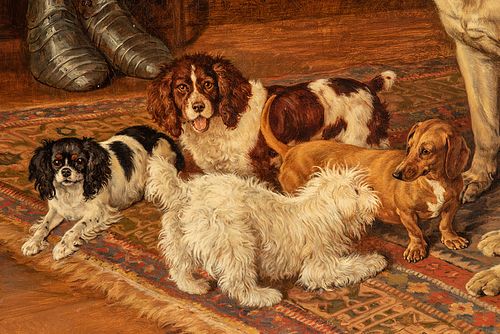FRANK PATON (Stepney, London, 1855-1909). "Dogs indoors," 1890. Oil on canvas.
Lot 70
About Seller
Setdart Auction House
Carrer Aragó 346
Barcelona
Spain
Setdart Subastas was born in 2004 and is currently the first online art auction in Spain with solidity, prestige and reliability guaranteed by our more than 60,000 users. Setdart has a young, dynamic and enterprising team ready to successfully manage the purchase and sale of art works through custom...Read more
Estimate:
EUR€10,000 - EUR€12,000
$10,752.69 - $12,903.23
Absentee vs Live bid
Two ways to bid:
- Leave a max absentee bid and the platform will bid on your behalf up to your maximum bid during the live auction.
- Bid live during the auction and your bids will be submitted real-time to the auctioneer.
Bid Increments
| Price | Bid Increment |
|---|---|
| EUR€0 | EUR€10 |
| EUR€200 | EUR€25 |
| EUR€500 | EUR€50 |
| EUR€1,000 | EUR€100 |
| EUR€3,000 | EUR€200 |
| EUR€5,000 | EUR€500 |
| EUR€10,000 | EUR€1,000 |
| EUR€20,000 | EUR€2,000 |
| EUR€50,000 | EUR€5,000 |
About Auction
By Setdart Auction House
Nov 10, 2021
Set Reminder
2021-11-10 08:00:00
2021-11-10 08:00:00
America/New_York
Bidsquare
Bidsquare : 19th & 20th Century paintings and Decorative Arts
https://www.bidsquare.com/auctions/setdart-auction-house/19th-20th-century-paintings-and-decorative-arts-7800
Setdart Auction House sofia@setdart.com
Setdart Auction House sofia@setdart.com
- Lot Description
FRANK PATON (Stepney, London, 1855-1909). "Dogs indoors," 1890. Oil on canvas. Period frame. Measurements: 92 x 128 cm; 112 x 148 cm (frame). A painter who specialized in painting animals and scenes of rural life, Frank Paton was a successful artist during his lifetime. Among his most devoted clientele was Queen Victoria. Paton was a precocious artist: as early as age sixteen he had his first known exhibition. It is rumored that Paton briefly spent time in France working in stained glass before being called upon by his father. It is believed that he then traveled and earned a living in Australia. Upon his return to England, Paton was accepted for his work "You Are No Chicken" at the Royal Academy, an aspect that attracted numerous collectors who decided to invest in his work. "You Are No Chicken" was engraved on mezzotint by J B Pratt in 1880. Its commercial success cemented a lifelong association with collector Leggatt, who became the principal publisher of Frank Paton's work. Although he was never a member of the Royal Academy, a total of 20 works by Paton were exhibited at its annual sale exhibition between the years 1878 and 1890. After this year, Frank Paton stopped exhibiting at the Royal Academy following a dispute with the organizers. His firmly established reputation led him to continue working until his last days. Along with the hunting theme, the representation of domestic animals was a very common subject in nineteenth-century society, since there were painters who specialized in painting animals. In this type of compositions, domestic animals were usually treated as we see here, with great naturalism and expressiveness, paying special attention to anatomical details, fur, facial expressions, etc., immortalized in ostentatious interiors typical of the wealthy bourgeois classes. The present work, a faithful follower of this genre, shows us up to six dogs of different breeds (mastiff, bichon, cavalier and dachshund), all of them arranged on a carpet of grecian design, in a clearly bourgeois interior in which even a metallic armor appears. It is a harmonious work in its palette of colors and lighting, intended to decorate the interior of nineteenth-century wealthy homes.
- Shipping Info
-
In-house shipping available. Please inquire at admin@setdart.com.
-
- Buyer's Premium



 EUR
EUR CAD
CAD AUD
AUD GBP
GBP MXN
MXN HKD
HKD CNY
CNY MYR
MYR SEK
SEK SGD
SGD CHF
CHF THB
THB

















